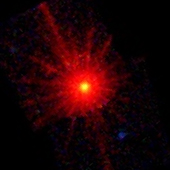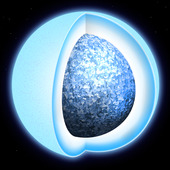ESA Science & Technology - News Archive
News archive
News archive
Astronomers developed a mosaic of the distant Universe that documents 16 years of observations from the NASA/ESA Hubble Space Telescope. The image, called the Hubble Legacy Field, contains roughly 265 000 galaxies that stretch back to just 500 million years after the Big Bang.
Published: 2 May 2019
While ESA's Gaia mission has been surveying more than one billion stars from space, astronomers have been regularly monitoring the satellite's position in the sky with telescopes across the world, including the European Southern Observatory in Chile, to further refine Gaia's orbit and ultimately improve the accuracy of its stellar census.
Published: 2 May 2019
Hubble's measurements of today's expansion rate do not match the rate that was expected based on how the Universe appeared shortly after the Big Bang over 13 billion years ago. Using new data from the NASA/ESA Hubble Space Telescope, astronomers have significantly lowered the possibility that this discrepancy is a fluke.
Published: 25 April 2019
This incredible image of the hourglass-shaped Southern Crab Nebula was taken to mark the NASA/ESA Hubble Space Telescope's 29th anniversary in space. The nebula, created by a binary star system, is one of the many objects that Hubble has demystified throughout its productive life.
Published: 18 April 2019
Scientists have used the tiny distortions imprinted on the cosmic microwave background by the gravity of matter throughout the Universe, recorded by ESA's Planck satellite, to uncover the connection between the luminosity of quasars – the bright cores of active galaxies – and the mass of the much larger 'halos' of dark matter in which they sit.
Published: 17 April 2019
The first batch of charge-coupled devices, or CCDs, to be flown on ESA's PLATO space observatory was accepted by ESA last month. This is an important milestone on the road to creating a groundbreaking spacecraft that will detect Earth-sized exoplanets in orbit around nearby stars.
Published: 11 April 2019
By surveying the centre of our Galaxy, ESA's XMM-Newton has discovered two colossal 'chimneys' funneling material from the vicinity of the Milky Way's supermassive black hole into two huge cosmic bubbles.
Published: 20 March 2019
Media representatives are invited to apply for accreditation to visit the CHEOPS spacecraft, which is in the clean rooms of Airbus in Madrid, on 29 March, before it goes into storage ahead of its shipment to Kourou later this year.
Published: 19 March 2019
Proposals are solicited in response to the first Announcement of Opportunity - AO-1 - for observing time in the CHEOPS Guest Observers Programme. This AO covers the period February 2020 to January 2021. The deadline for proposals has passed.
Published: 19 March 2019
In a striking example of multi-mission astronomy, measurements from the NASA/ESA Hubble Space Telescope and the ESA Gaia mission have been combined to improve the estimate of the mass of our home galaxy the Milky Way: 1.5 trillion solar masses.
Published: 7 March 2019
ESA's Gaia satellite is on a mission: to map and characterise more than one billion of the stars in the Milky Way. Many of these stars reside in complex, eye-catching clusters scattered throughout our Galaxy and, by studying these stellar groupings, Gaia is revealing much about the formation and evolution of stars in our cosmic home and...
Published: 26 February 2019
Proposals are solicited for observations with INTEGRAL in response to the Seventeenth Announcement of Opportunity, AO-17, issued 25 February 2019. This AO covers the period January 2020 to December 2020.
Published: 25 February 2019
ESA's Gaia satellite has looked beyond our Galaxy and explored two nearby galaxies to reveal the stellar motions within them and how they will one day interact and collide with the Milky Way – with surprising results.
Published: 7 February 2019
Astronomers using the NASA/ESA Hubble Space Telescope to study some of the oldest and faintest stars in the globular cluster NGC 6752 have made an unexpected finding. They discovered a dwarf galaxy in our cosmic backyard, only 30 million light-years away.
Published: 31 January 2019
Investigating the history of our cosmos with a large sample of distant 'active' galaxies observed by ESA's XMM-Newton, a team of astronomers found there might be more to the early expansion of the Universe than predicted by the standard model of cosmology.
Published: 28 January 2019
ESA's high-energy space telescopes INTEGRAL and XMM-Newton have helped to find a source of powerful X-rays at the centre of an unprecedentedly bright and rapidly evolving stellar explosion that suddenly appeared in the sky earlier this year.
Published: 10 January 2019
The NASA/ESA Hubble Space Telescope has discovered the brightest quasar ever seen in the early Universe. After 20 years of searching, astronomers have identified the ancient quasar with the help of strong gravitational lensing.
Published: 9 January 2019
Astronomers using ESA's XMM-Newton space observatory have studied a black hole devouring a star and discovered an exceptionally bright and stable signal that allowed them to determine the black hole's spin rate.
Published: 9 January 2019
Data captured by ESA's galaxy-mapping spacecraft Gaia has revealed for the first time how white dwarfs, the dead remnants of stars like our Sun, turn into solid spheres as the hot gas inside them cools down.
Published: 9 January 2019
The NASA/ESA Hubble Space Telescope has captured the most detailed image yet of a close neighbour of the Milky Way – the Triangulum Galaxy, a spiral galaxy located at a distance of only three million light-years.
Published: 7 January 2019
—
20 Items per Page




















